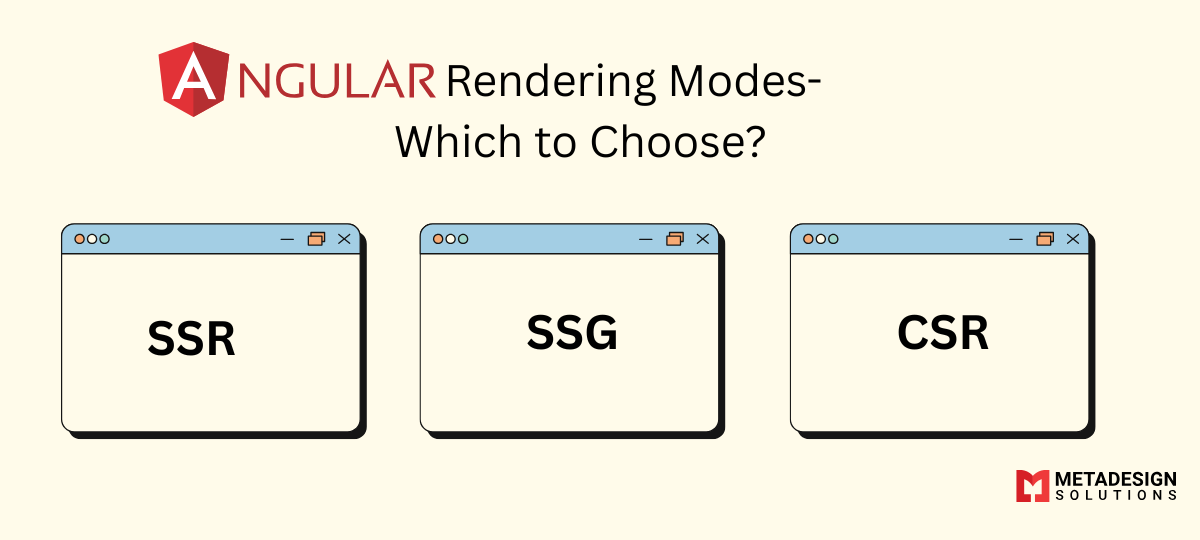Introduction:
Angular is a powerful framework that allows developers to build dynamic and high-performance web applications. However, one of the key decisions during Angular development is choosing the right rendering mode for your application: Server-Side Rendering (SSR), Static Site Generation (SSG), or Client-Side Rendering (CSR). Each of these rendering strategies offers distinct advantages and trade-offs in terms of performance, SEO, and user experience.
In this guide, we will break down the differences between SSR, SSG, and CSR in Angular, explore their benefits and drawbacks, and help you determine which rendering mode best suits your use case.
1. Understanding the Rendering Modes
1.1. Client-Side Rendering (CSR)
Client-Side Rendering (CSR) is the default rendering mode in Angular. In CSR, the initial page load sends only minimal HTML, CSS, and JavaScript to the browser. The browser then uses JavaScript to dynamically render the content of the page. This means that once the JavaScript bundle is loaded, Angular handles all the rendering of the user interface on the client-side.
How CSR Works:
- The browser requests the app’s HTML, CSS, and JavaScript files.
- The browser loads and executes JavaScript to render the UI.
- Subsequent navigation happens within the app without reloading the page (via Angular’s routing and data binding).
Pros of CSR:
- Faster interactions after initial load: Once the app is loaded, interactions are quick as the client handles rendering.
- Rich User Interfaces: CSR allows for the creation of highly interactive and dynamic web applications, such as single-page applications (SPAs).
- Less Server Load: Since most of the work is done on the client side, the server is less burdened after the initial load.
Cons of CSR:
- Slower Initial Load Time: Since the browser needs to load and execute JavaScript to render the content, the initial page load can be slow, especially for larger applications.
- SEO Limitations: Search engines may struggle to index dynamic content rendered entirely through JavaScript, leading to potential SEO challenges.
Example of CSR in Angular:
typescript code:
@Component({
selector: 'app-home',
template: `<h1>{{ message }}</h1>`
})
export class HomeComponent {
message = 'Welcome to the Angular CSR App!';
}
The app would render dynamically in the browser after loading the JavaScript bundle.
1.2. Server-Side Rendering (SSR)
Server-Side Rendering (SSR) renders the initial HTML of an Angular app on the server. Instead of relying solely on JavaScript to render content, the server pre-renders the HTML for the user’s browser. Once the initial page is loaded, the Angular app takes over to provide a seamless, interactive experience. SSR in Angular is typically implemented using Angular Universal.
How SSR Works:
- The server pre-renders the HTML, CSS, and JavaScript, sending fully-rendered HTML to the client.
- The initial page load is fast as the browser receives pre-rendered content.
- Angular then takes over on the client-side, making the app interactive and handling subsequent navigations.
Pros of SSR:
- Faster Initial Load: Since the server pre-renders the HTML, the initial page load is much faster, especially for users with slower internet connections or devices.
- SEO Benefits: Search engines can easily crawl and index pre-rendered content, which is a significant advantage for SEO.
- Improved Performance for Content-heavy Sites: SSR is ideal for sites with lots of static content (e.g., blogs, product pages) because it provides fast loading times and better SEO.
Cons of SSR:
- Increased Server Load: Since the server must render the HTML on every request, SSR can increase the load on the server, especially for high-traffic applications.
- Complexity in Setup: Setting up SSR with Angular Universal can be more complex than CSR, especially when integrating with third-party services or data.
Example of SSR in Angular (Angular Universal):
typescript code:
// server.ts
import 'zone.js';
import { enableProdMode } from '@angular/core';
import { platformBrowserDynamic } from '@angular/platform-browser-dynamic';
import { AppModule } from './app/app.module';
import { AppServerModule } from './app/app.server.module';
enableProdMode();
platformBrowserDynamic().bootstrapModule(AppServerModule);
The app is server-rendered using Angular Universal, providing a fast first-load experience.
Need Help Choosing the Right Rendering Mode for Your Angular App?
1.3. Static Site Generation (SSG)
Static Site Generation (SSG) is a technique where pages are pre-rendered at build time, creating a set of static HTML files for the entire site. These pages are then served directly to users without any JavaScript processing on the client-side. SSG is often used for blogs, documentation, and marketing websites, where the content doesn’t change frequently.
How SSG Works:
- The build process pre-renders all the pages and generates static HTML files for each route.
- These static files are served directly from a CDN or static file server.
- No client-side rendering is required for the initial load, making it fast and SEO-friendly.
Pros of SSG:
- Ultra-Fast Load Times: Since the content is pre-generated and served as static files, the page loads are instantaneous.
- SEO-Friendly: Because the content is already pre-rendered, search engines can easily index it.
- Low Server Load: Once the pages are pre-built, the server simply serves static files, reducing server load and improving scalability.
Cons of SSG:
- Limited Dynamic Content: SSG is not ideal for applications that require dynamic or real-time content (e.g., user-generated content, live data feeds).
- Build Time: If you have a large number of pages, the build process can take a significant amount of time.
Example of SSG in Angular using a Static Site Generator:
typescript code:
// app.component.ts
@Component({
selector: 'app-home',
template: `<h1>{{ message }}</h1>`
})
export class HomeComponent {
message = 'Welcome to the Angular SSG Site!';
}
This content will be pre-rendered during the build process and served as static HTML.
2. When to Choose SSR, SSG, or CSR?
2.1. When to Use CSR (Client-Side Rendering)
CSR is ideal when you’re building single-page applications (SPAs) or dynamic web apps where the primary goal is user interaction after the initial load. It’s perfect for applications that:
- Require rich interactivity and complex user interfaces.
- Need to provide a fast, app-like experience once loaded.
- Don’t rely heavily on SEO or content visibility by search engines.
Use CSR when:
- Building dynamic dashboards or data-heavy apps.
- Developing e-commerce platforms that focus on user interactions.
2.2. When to Use SSR (Server-Side Rendering)
SSR is the best choice for applications that need fast initial loading and SEO optimization. If your application involves content-heavy pages that must be indexed by search engines, such as blogs or product listings, SSR provides a major advantage.
- Great for SEO-driven content like blogs, articles, product pages, and news websites.
- Improves first-time user experience by delivering a fully-rendered page instantly.
Use SSR when:
- You want faster initial loads and better SEO.
- Your application needs real-time data with fast rendering, such as news websites or real-time services.
2.3. When to Use SSG (Static Site Generation)
SSG is perfect for websites where the content doesn’t change frequently, and SEO is important. It’s ideal for sites like:
- Marketing websites, portfolios, and blogs where the content is static.
- Documentation sites or product landing pages that don’t require dynamic content.
Use SSG when:
- You have a content-driven site (like a blog or documentation) where the content remains the same for long periods.
- You need to optimize for SEO with minimal server load.
3. Code Sample: How to Implement SSR and SSG in Angular
Implementing SSR in Angular (Angular Universal)
bash code:
ng add @nguniversal/express-engine
Once added, you can configure your app to be rendered on the server by creating a new server-side entry point.
typescript code:
// server.ts
import 'zone.js';
import { enableProdMode } from '@angular/core';
import { platformServerDynamic } from '@angular/platform-server';
import { AppServerModule } from './app/app.server.module';
enableProdMode();
platformServerDynamic().bootstrapModule(AppServerModule);
Implementing SSG in Angular
With Angular Static Site Generation (SSG), the build process generates static HTML files for every route:
bash code:
ng add @angular/localize
ng build --prod --static-site
The generated HTML files can then be served directly by any static file server or deployed to CDN for fast performance.
4. Conclusion: Choosing the Right Rendering Mode for Your Angular App
Choosing between CSR, SSR, and SSG depends entirely on your application’s goals and the user experience you want to deliver. CSR is perfect for dynamic, highly interactive apps, SSR is ideal for SEO and fast initial rendering, and SSG provides ultra-fast performance for content-driven sites.
When implemented by experts offering Angular development services, these rendering modes can be aligned with your specific business needs to ensure maximum impact. Understanding these techniques and applying them correctly can significantly improve performance, scalability, and user satisfaction for your Angular applications.
By leveraging Angular’s capabilities and choosing the right rendering strategy, you can ensure your web applications are fast, responsive, and optimized for both users and search engines.
Hashtag Related
#AngularRendering #SSRvsCSR #SSGvsSSR #AngularSSR #AngularSSG #AngularCSR #AngularRenderingModes #WebPerformance #AngularUniversal #AngularBestPractices #AngularDevelopment #AngularDevelopmentCompany #AngularDevelopmentServices #HireAngularDevelopers



